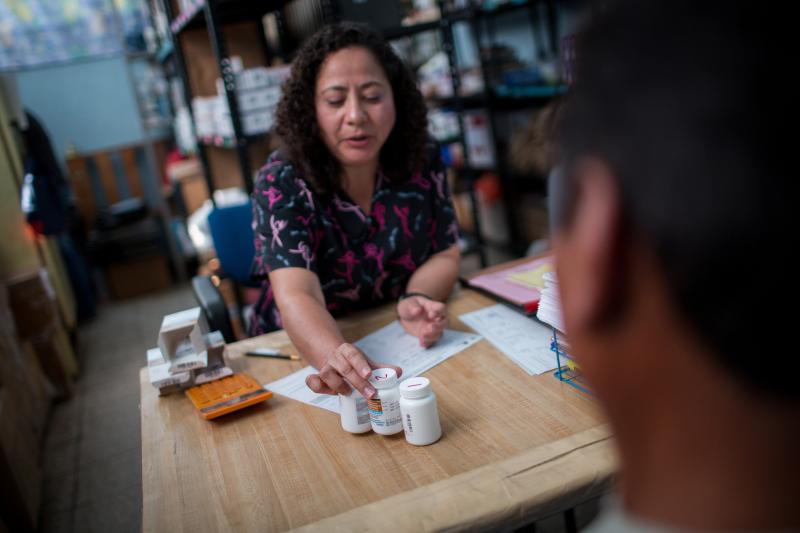Where We Work
See our interactive map


A health worker explains medication for a client at an HIV clinic at Escuintla Regional Hospital. Photo by Anna Watts for IntraHealth International.
With help from health workers and key investments, we believe we can.
This summer, we celebrated Botswana for being the first country in Africa with a high HIV burden to attain the UNAIDS 95/95/95 targets for 2030. PEPFAR also announced that at least 12 African countries have reached the 2020 90/90/90 targets.
Considering there was a time when many thought Africans were incapable of adhering to antiretroviral treatment, these accomplishments are indeed impressive.
Attaining 90/90/90 targets is a great achievement, but as HIV advocates, what we truly strive for is global epidemic control. PEPFAR defines this as the point at which the total number of new HIV infections falls below the total number of deaths from all causes among HIV-infected individuals.
And while we are close (nine high-burden countries have reached this point), more work is needed—work to reach global epidemic control, to sustain it, to identify remaining cases (particularly among children, adolescent girls, young women, and key populations), and to help those who are infected get and adhere to treatment to stop new infections.
So who will be doing much of this work?
It all comes down to the health worker.
Health workers are at the core of the work that has brought us this far. Community health workers in particular play a key role in HIV/AIDS response by addressing both social and health-related needs among their local populations. These roles became even more prominent during COVID-19, as they fostered innovations and flexibility—such as delivering antiretroviral drugs to clients’ homes rather than asking clients to visit health facilities—to make sure health services continued.
To help community health workers stay motivated and provide high-quality services, governments must ensure they undergo structured training and skills development and are compensated fairly for the work they do. That’s why continuing to invest in the health workforce, whether through funding from national governments or international plans like the Biden-Harris Global Health Worker Initiative, will help us reach sustained epidemic control.
National governments, funders, and the international nonprofit community can support health workers in this crucial work by investing in the following systems and approaches that help health workers do their jobs, both every day and during emergencies.
Wouldn’t it be great if countries could know just how many health workers they need to address gaps in care, what skills those health workers would require, and where exactly in the health system they should be placed? Wouldn’t they like to ensure their health workers are motivated to do their best work, that facilities are sufficiently staffed, and that health workers have the training they need to provide high-quality services that could contain the AIDS epidemic once and for all?
Digital health tools, like mHero and iHRIS—the ones we use at IntraHealth—can support governments and teams to do exactly that at all levels of the health system, including the community level. Currently, more than 25 countries use IntraHealth’s iHRIS software to manage their health worker personnel records. And we continue to improve these health applications and ensure they speak to each other and to national systems so they can be leveraged to address other emerging health threats.
Investing in such systems can help countries plan and manage their health workforces to most efficiently sustain HIV epidemic control.
HIV/AIDS has a disproportionate impact on certain population segments—adolescent girls, women, and sex workers, among others. So we have to pay special attention to gender equality, justice and human rights mechanisms, and inequalities in investments for programs that serve key populations in particular.
For a greater focus on gender equality, we must tailor interventions to address gender-related barriers that stand between these groups and the health services they need. Intimate partner violence, stigma, and discrimination increase HIV vulnerabilities and can take away a person’s ability to negotiate safe sex or access treatment and support services from nearby health facilities. Targeted interventions can help stakeholders at the community level participate more holistically in solving these issues and create demand-responsive systems for better program implementation, political ownership and stewardship, institutional and community ownership, and mutual accountability.
A people-centered approach that defies the one-size-fits-all notion is essential to reaching HIV epidemic control. A differentiated services delivery model for all in HIV care systems is key. That means tailoring services to match diverse needs and improve quality of life while scaling up HIV services. Services must be sensitive to social protection for all people living with and those affected by HIV/AIDS in a way that allows refills at a client’s doorstep when they miss their ART clinic appointment.
To do this, we must amplify community voices and maximize media as an advocacy tool to demand better services, social protection, and policies. We must call for unity and accountable governments that meet community welfare needs. We also must call on governments to further counter discriminative and punitive laws and unequal services, such as unmet PrEP supplies, unlawful criminalization of key populations, inadequate efforts to curb gender-based violence, and stigma and discrimination, among others.
Governments must develop and hasten intellectual property systems that mitigate hoarding drugs, vaccines, and scientific research findings, all of which further increase inequality.
We have the tools to attain our global HIV goals. But sustaining these goals will require a community-driven process that fosters strategic and sustained investments in the global health workforce.
Get the latest updates from the blog and eNews




